HRMT20024 - Annotated Bibliography: HR Practices in Retail Industry
VerifiedAdded on 2023/06/13
|10
|2768
|241
Annotated Bibliography
AI Summary
This annotated bibliography provides an overview of several peer-reviewed journal articles related to human resource management (HRM) within the retail industry, particularly focusing on trends, high-performance work systems, enterprise architecture, and employee-related factors such as job satisfaction and turnover intention. The articles examine HRM practices in Australia, Malaysia, and the United States, highlighting the strengths and weaknesses of different approaches. Key themes include the impact of technology on HRM, the role of HR managers, and the importance of organizational commitment and employee well-being. Each annotation summarizes the main ideas, research methodologies, and conclusions of the respective articles, further providing insights into how the information can be used for further research and essay writing. Desklib provides a platform to access this document and other resources.
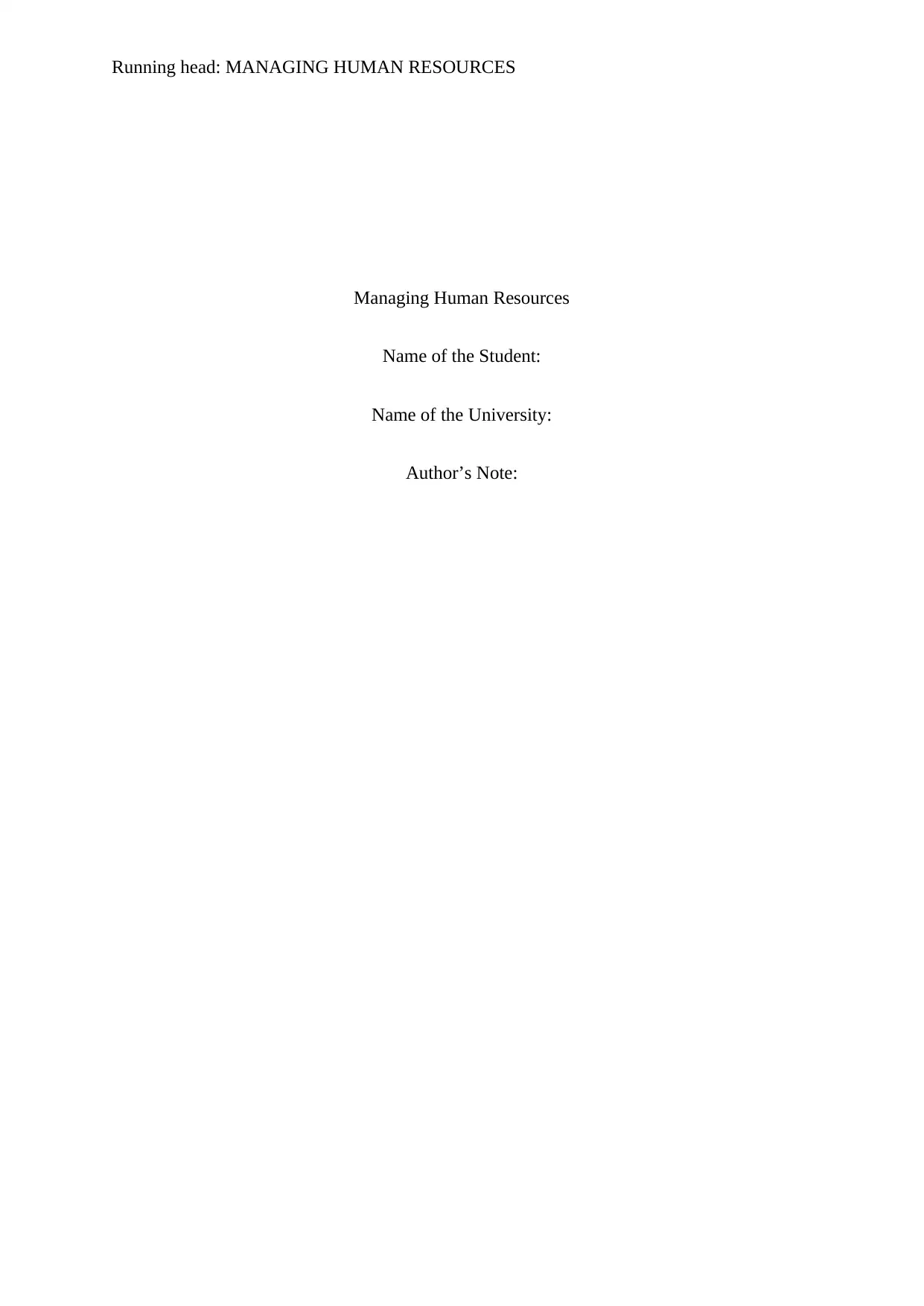
Running head: MANAGING HUMAN RESOURCES
Managing Human Resources
Name of the Student:
Name of the University:
Author’s Note:
Managing Human Resources
Name of the Student:
Name of the University:
Author’s Note:
Paraphrase This Document
Need a fresh take? Get an instant paraphrase of this document with our AI Paraphraser
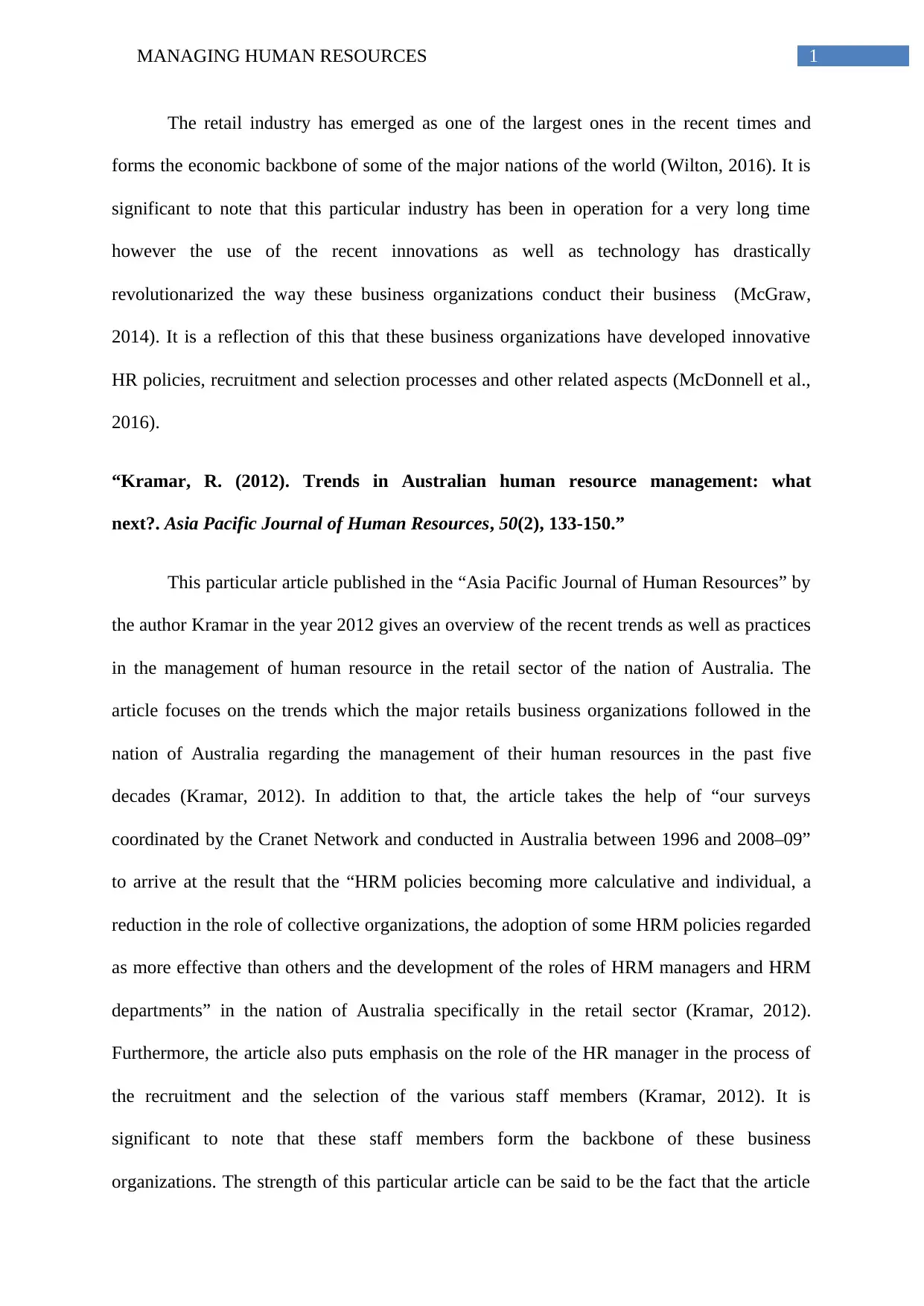
1MANAGING HUMAN RESOURCES
The retail industry has emerged as one of the largest ones in the recent times and
forms the economic backbone of some of the major nations of the world (Wilton, 2016). It is
significant to note that this particular industry has been in operation for a very long time
however the use of the recent innovations as well as technology has drastically
revolutionarized the way these business organizations conduct their business (McGraw,
2014). It is a reflection of this that these business organizations have developed innovative
HR policies, recruitment and selection processes and other related aspects (McDonnell et al.,
2016).
“Kramar, R. (2012). Trends in Australian human resource management: what
next?. Asia Pacific Journal of Human Resources, 50(2), 133-150.”
This particular article published in the “Asia Pacific Journal of Human Resources” by
the author Kramar in the year 2012 gives an overview of the recent trends as well as practices
in the management of human resource in the retail sector of the nation of Australia. The
article focuses on the trends which the major retails business organizations followed in the
nation of Australia regarding the management of their human resources in the past five
decades (Kramar, 2012). In addition to that, the article takes the help of “our surveys
coordinated by the Cranet Network and conducted in Australia between 1996 and 2008–09”
to arrive at the result that the “HRM policies becoming more calculative and individual, a
reduction in the role of collective organizations, the adoption of some HRM policies regarded
as more effective than others and the development of the roles of HRM managers and HRM
departments” in the nation of Australia specifically in the retail sector (Kramar, 2012).
Furthermore, the article also puts emphasis on the role of the HR manager in the process of
the recruitment and the selection of the various staff members (Kramar, 2012). It is
significant to note that these staff members form the backbone of these business
organizations. The strength of this particular article can be said to be the fact that the article
The retail industry has emerged as one of the largest ones in the recent times and
forms the economic backbone of some of the major nations of the world (Wilton, 2016). It is
significant to note that this particular industry has been in operation for a very long time
however the use of the recent innovations as well as technology has drastically
revolutionarized the way these business organizations conduct their business (McGraw,
2014). It is a reflection of this that these business organizations have developed innovative
HR policies, recruitment and selection processes and other related aspects (McDonnell et al.,
2016).
“Kramar, R. (2012). Trends in Australian human resource management: what
next?. Asia Pacific Journal of Human Resources, 50(2), 133-150.”
This particular article published in the “Asia Pacific Journal of Human Resources” by
the author Kramar in the year 2012 gives an overview of the recent trends as well as practices
in the management of human resource in the retail sector of the nation of Australia. The
article focuses on the trends which the major retails business organizations followed in the
nation of Australia regarding the management of their human resources in the past five
decades (Kramar, 2012). In addition to that, the article takes the help of “our surveys
coordinated by the Cranet Network and conducted in Australia between 1996 and 2008–09”
to arrive at the result that the “HRM policies becoming more calculative and individual, a
reduction in the role of collective organizations, the adoption of some HRM policies regarded
as more effective than others and the development of the roles of HRM managers and HRM
departments” in the nation of Australia specifically in the retail sector (Kramar, 2012).
Furthermore, the article also puts emphasis on the role of the HR manager in the process of
the recruitment and the selection of the various staff members (Kramar, 2012). It is
significant to note that these staff members form the backbone of these business
organizations. The strength of this particular article can be said to be the fact that the article

2MANAGING HUMAN RESOURCES
uses extensive research for the derivation of the desired data which was necessary to arrive at
the conclusions made in the article. Furthermore, the style of writing used by the author is
very simple as well as persuasive which is likely to help the readers. The weakness of the
article can be said that to be the fact that the article uses past data to arrive at the conclusions
outlined in the article without taking into consideration the present scenario or the
advancement made by the industry after the advancement of technology.
It is significant to note that this particular gives an overview of the various “human
resource management” policies which the various retail business organizations nation of
Australia have followed in the last five decades. Therefore, the content of this particular
article will provide valuable information for the Assessment 3 Essay.
“Boxall, P. (2012). High‐performance work systems: what, why, how and for
whom?. Asia Pacific Journal of Human Resources, 50(2), 169-186.”
This particular article by the author Boxall published in the “Asia Pacific Journal of
Human Resources” in the year 2012 intends to give an overview of the importance of high
level of performance among the employees in the Australian retail industry and the policies
adopted by the “human resource management” for the effective achievement of this purpose.
The primary focus of the article is on the “two lines of analysis in the high-performance work
systems literature that are important for HR researchers and strategists” which are considered
the core concepts in the retail sector of the Australian business environment (Boxall, 2012).
Furthermore, the emphasis of the article is also on the “analysis of the chain of links that
exists inside the ‘blackbox’ of HRM, helping us to assess issues of mutuality and
sustainability in employment relationships” (Boxall, 2012). The author Boxall in this
particular article also argues for the process of mapping out the diversity which exists in the
retail sector workplace and also tries to understand the factors which are more likely to
uses extensive research for the derivation of the desired data which was necessary to arrive at
the conclusions made in the article. Furthermore, the style of writing used by the author is
very simple as well as persuasive which is likely to help the readers. The weakness of the
article can be said that to be the fact that the article uses past data to arrive at the conclusions
outlined in the article without taking into consideration the present scenario or the
advancement made by the industry after the advancement of technology.
It is significant to note that this particular gives an overview of the various “human
resource management” policies which the various retail business organizations nation of
Australia have followed in the last five decades. Therefore, the content of this particular
article will provide valuable information for the Assessment 3 Essay.
“Boxall, P. (2012). High‐performance work systems: what, why, how and for
whom?. Asia Pacific Journal of Human Resources, 50(2), 169-186.”
This particular article by the author Boxall published in the “Asia Pacific Journal of
Human Resources” in the year 2012 intends to give an overview of the importance of high
level of performance among the employees in the Australian retail industry and the policies
adopted by the “human resource management” for the effective achievement of this purpose.
The primary focus of the article is on the “two lines of analysis in the high-performance work
systems literature that are important for HR researchers and strategists” which are considered
the core concepts in the retail sector of the Australian business environment (Boxall, 2012).
Furthermore, the emphasis of the article is also on the “analysis of the chain of links that
exists inside the ‘blackbox’ of HRM, helping us to assess issues of mutuality and
sustainability in employment relationships” (Boxall, 2012). The author Boxall in this
particular article also argues for the process of mapping out the diversity which exists in the
retail sector workplace and also tries to understand the factors which are more likely to
⊘ This is a preview!⊘
Do you want full access?
Subscribe today to unlock all pages.

Trusted by 1+ million students worldwide
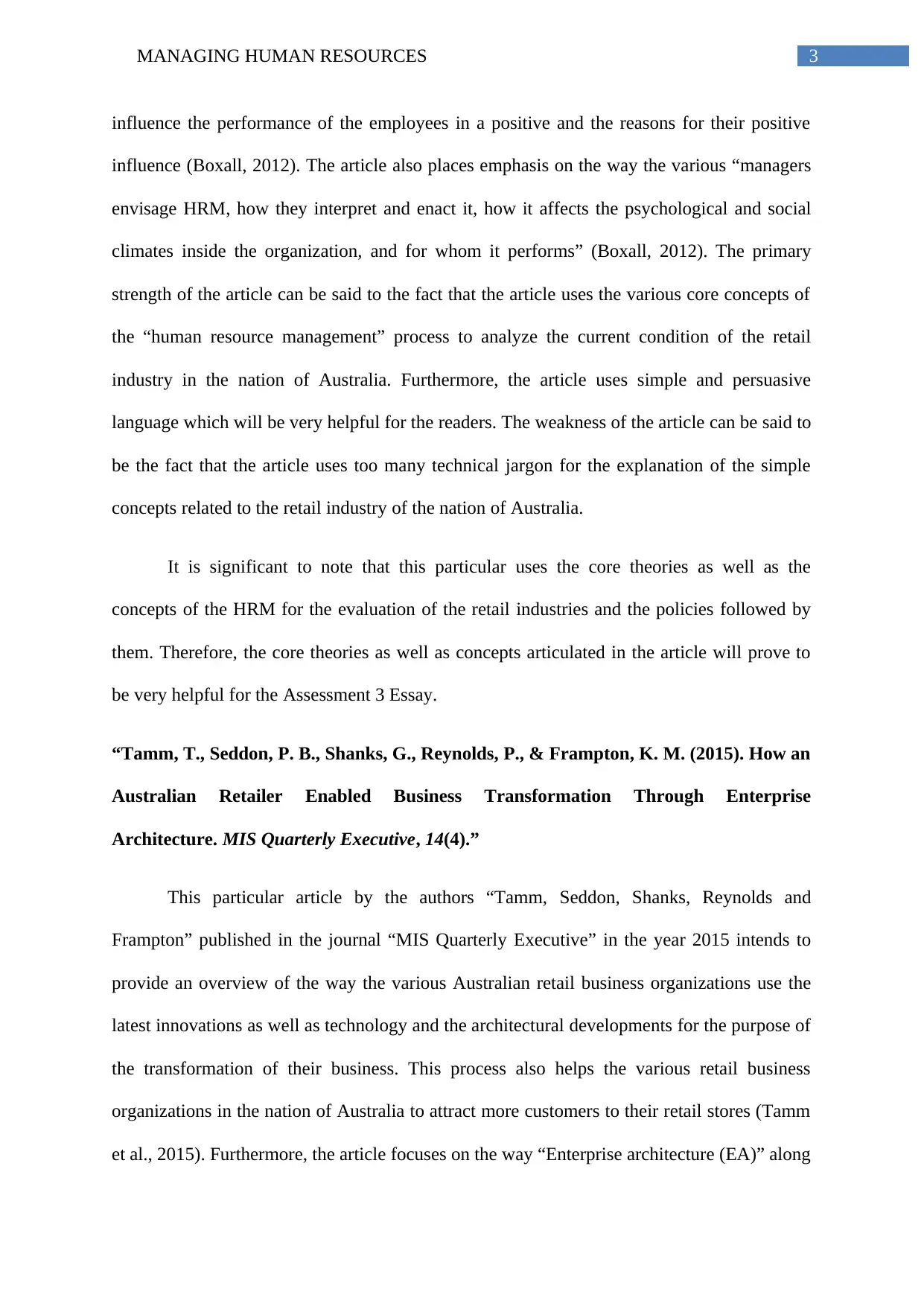
3MANAGING HUMAN RESOURCES
influence the performance of the employees in a positive and the reasons for their positive
influence (Boxall, 2012). The article also places emphasis on the way the various “managers
envisage HRM, how they interpret and enact it, how it affects the psychological and social
climates inside the organization, and for whom it performs” (Boxall, 2012). The primary
strength of the article can be said to the fact that the article uses the various core concepts of
the “human resource management” process to analyze the current condition of the retail
industry in the nation of Australia. Furthermore, the article uses simple and persuasive
language which will be very helpful for the readers. The weakness of the article can be said to
be the fact that the article uses too many technical jargon for the explanation of the simple
concepts related to the retail industry of the nation of Australia.
It is significant to note that this particular uses the core theories as well as the
concepts of the HRM for the evaluation of the retail industries and the policies followed by
them. Therefore, the core theories as well as concepts articulated in the article will prove to
be very helpful for the Assessment 3 Essay.
“Tamm, T., Seddon, P. B., Shanks, G., Reynolds, P., & Frampton, K. M. (2015). How an
Australian Retailer Enabled Business Transformation Through Enterprise
Architecture. MIS Quarterly Executive, 14(4).”
This particular article by the authors “Tamm, Seddon, Shanks, Reynolds and
Frampton” published in the journal “MIS Quarterly Executive” in the year 2015 intends to
provide an overview of the way the various Australian retail business organizations use the
latest innovations as well as technology and the architectural developments for the purpose of
the transformation of their business. This process also helps the various retail business
organizations in the nation of Australia to attract more customers to their retail stores (Tamm
et al., 2015). Furthermore, the article focuses on the way “Enterprise architecture (EA)” along
influence the performance of the employees in a positive and the reasons for their positive
influence (Boxall, 2012). The article also places emphasis on the way the various “managers
envisage HRM, how they interpret and enact it, how it affects the psychological and social
climates inside the organization, and for whom it performs” (Boxall, 2012). The primary
strength of the article can be said to the fact that the article uses the various core concepts of
the “human resource management” process to analyze the current condition of the retail
industry in the nation of Australia. Furthermore, the article uses simple and persuasive
language which will be very helpful for the readers. The weakness of the article can be said to
be the fact that the article uses too many technical jargon for the explanation of the simple
concepts related to the retail industry of the nation of Australia.
It is significant to note that this particular uses the core theories as well as the
concepts of the HRM for the evaluation of the retail industries and the policies followed by
them. Therefore, the core theories as well as concepts articulated in the article will prove to
be very helpful for the Assessment 3 Essay.
“Tamm, T., Seddon, P. B., Shanks, G., Reynolds, P., & Frampton, K. M. (2015). How an
Australian Retailer Enabled Business Transformation Through Enterprise
Architecture. MIS Quarterly Executive, 14(4).”
This particular article by the authors “Tamm, Seddon, Shanks, Reynolds and
Frampton” published in the journal “MIS Quarterly Executive” in the year 2015 intends to
provide an overview of the way the various Australian retail business organizations use the
latest innovations as well as technology and the architectural developments for the purpose of
the transformation of their business. This process also helps the various retail business
organizations in the nation of Australia to attract more customers to their retail stores (Tamm
et al., 2015). Furthermore, the article focuses on the way “Enterprise architecture (EA)” along
Paraphrase This Document
Need a fresh take? Get an instant paraphrase of this document with our AI Paraphraser
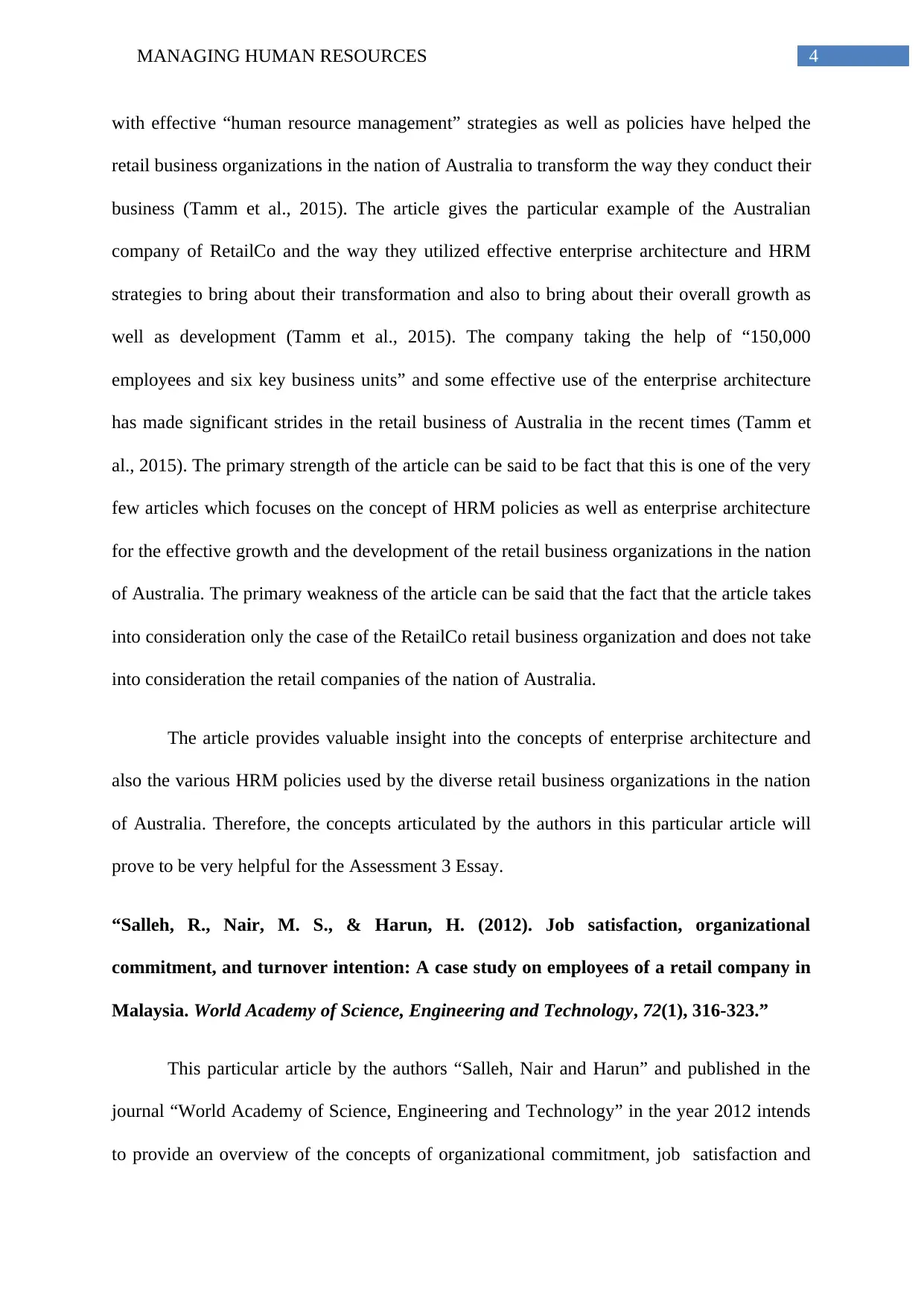
4MANAGING HUMAN RESOURCES
with effective “human resource management” strategies as well as policies have helped the
retail business organizations in the nation of Australia to transform the way they conduct their
business (Tamm et al., 2015). The article gives the particular example of the Australian
company of RetailCo and the way they utilized effective enterprise architecture and HRM
strategies to bring about their transformation and also to bring about their overall growth as
well as development (Tamm et al., 2015). The company taking the help of “150,000
employees and six key business units” and some effective use of the enterprise architecture
has made significant strides in the retail business of Australia in the recent times (Tamm et
al., 2015). The primary strength of the article can be said to be fact that this is one of the very
few articles which focuses on the concept of HRM policies as well as enterprise architecture
for the effective growth and the development of the retail business organizations in the nation
of Australia. The primary weakness of the article can be said that the fact that the article takes
into consideration only the case of the RetailCo retail business organization and does not take
into consideration the retail companies of the nation of Australia.
The article provides valuable insight into the concepts of enterprise architecture and
also the various HRM policies used by the diverse retail business organizations in the nation
of Australia. Therefore, the concepts articulated by the authors in this particular article will
prove to be very helpful for the Assessment 3 Essay.
“Salleh, R., Nair, M. S., & Harun, H. (2012). Job satisfaction, organizational
commitment, and turnover intention: A case study on employees of a retail company in
Malaysia. World Academy of Science, Engineering and Technology, 72(1), 316-323.”
This particular article by the authors “Salleh, Nair and Harun” and published in the
journal “World Academy of Science, Engineering and Technology” in the year 2012 intends
to provide an overview of the concepts of organizational commitment, job satisfaction and
with effective “human resource management” strategies as well as policies have helped the
retail business organizations in the nation of Australia to transform the way they conduct their
business (Tamm et al., 2015). The article gives the particular example of the Australian
company of RetailCo and the way they utilized effective enterprise architecture and HRM
strategies to bring about their transformation and also to bring about their overall growth as
well as development (Tamm et al., 2015). The company taking the help of “150,000
employees and six key business units” and some effective use of the enterprise architecture
has made significant strides in the retail business of Australia in the recent times (Tamm et
al., 2015). The primary strength of the article can be said to be fact that this is one of the very
few articles which focuses on the concept of HRM policies as well as enterprise architecture
for the effective growth and the development of the retail business organizations in the nation
of Australia. The primary weakness of the article can be said that the fact that the article takes
into consideration only the case of the RetailCo retail business organization and does not take
into consideration the retail companies of the nation of Australia.
The article provides valuable insight into the concepts of enterprise architecture and
also the various HRM policies used by the diverse retail business organizations in the nation
of Australia. Therefore, the concepts articulated by the authors in this particular article will
prove to be very helpful for the Assessment 3 Essay.
“Salleh, R., Nair, M. S., & Harun, H. (2012). Job satisfaction, organizational
commitment, and turnover intention: A case study on employees of a retail company in
Malaysia. World Academy of Science, Engineering and Technology, 72(1), 316-323.”
This particular article by the authors “Salleh, Nair and Harun” and published in the
journal “World Academy of Science, Engineering and Technology” in the year 2012 intends
to provide an overview of the concepts of organizational commitment, job satisfaction and
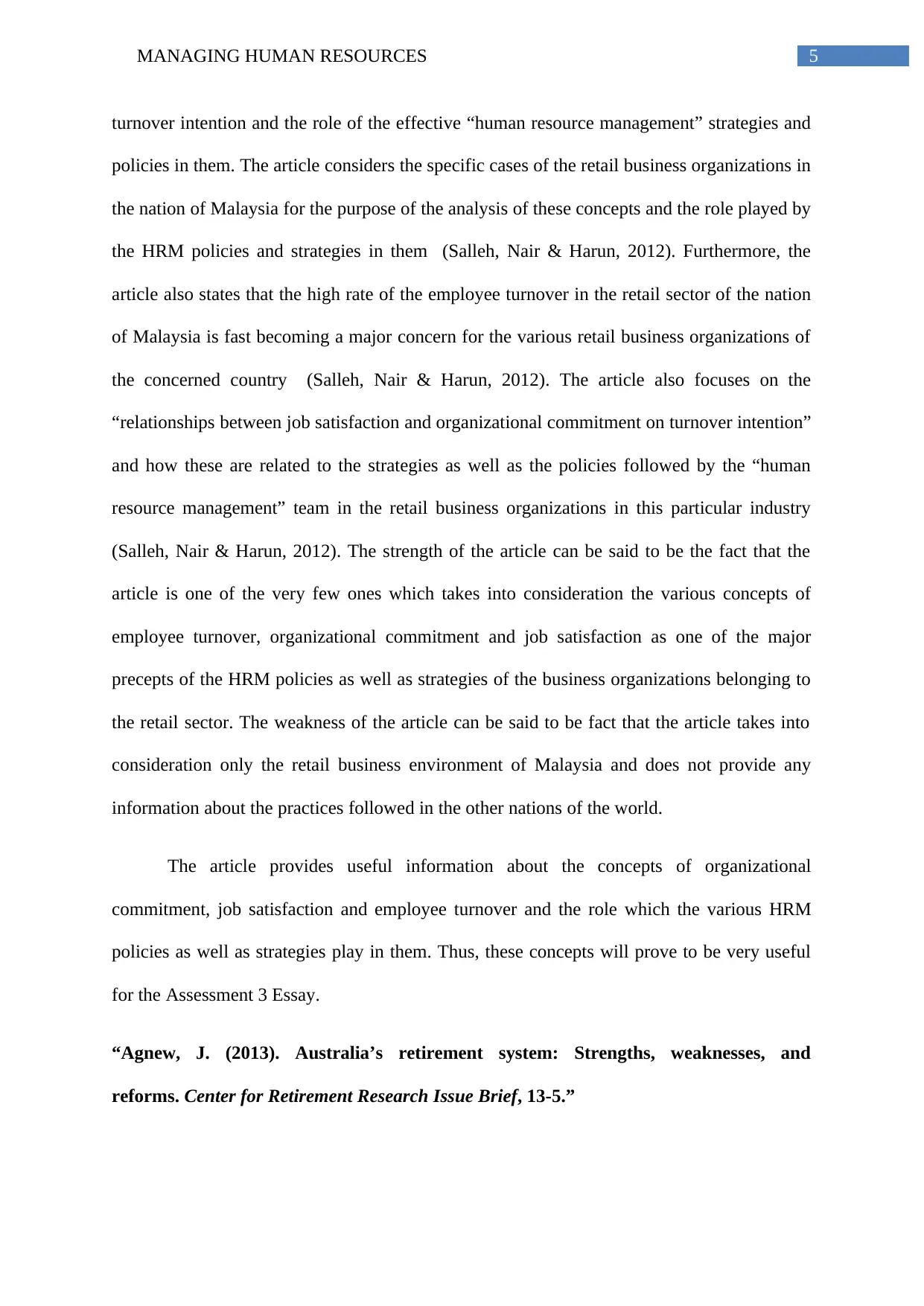
5MANAGING HUMAN RESOURCES
turnover intention and the role of the effective “human resource management” strategies and
policies in them. The article considers the specific cases of the retail business organizations in
the nation of Malaysia for the purpose of the analysis of these concepts and the role played by
the HRM policies and strategies in them (Salleh, Nair & Harun, 2012). Furthermore, the
article also states that the high rate of the employee turnover in the retail sector of the nation
of Malaysia is fast becoming a major concern for the various retail business organizations of
the concerned country (Salleh, Nair & Harun, 2012). The article also focuses on the
“relationships between job satisfaction and organizational commitment on turnover intention”
and how these are related to the strategies as well as the policies followed by the “human
resource management” team in the retail business organizations in this particular industry
(Salleh, Nair & Harun, 2012). The strength of the article can be said to be the fact that the
article is one of the very few ones which takes into consideration the various concepts of
employee turnover, organizational commitment and job satisfaction as one of the major
precepts of the HRM policies as well as strategies of the business organizations belonging to
the retail sector. The weakness of the article can be said to be fact that the article takes into
consideration only the retail business environment of Malaysia and does not provide any
information about the practices followed in the other nations of the world.
The article provides useful information about the concepts of organizational
commitment, job satisfaction and employee turnover and the role which the various HRM
policies as well as strategies play in them. Thus, these concepts will prove to be very useful
for the Assessment 3 Essay.
“Agnew, J. (2013). Australia’s retirement system: Strengths, weaknesses, and
reforms. Center for Retirement Research Issue Brief, 13-5.”
turnover intention and the role of the effective “human resource management” strategies and
policies in them. The article considers the specific cases of the retail business organizations in
the nation of Malaysia for the purpose of the analysis of these concepts and the role played by
the HRM policies and strategies in them (Salleh, Nair & Harun, 2012). Furthermore, the
article also states that the high rate of the employee turnover in the retail sector of the nation
of Malaysia is fast becoming a major concern for the various retail business organizations of
the concerned country (Salleh, Nair & Harun, 2012). The article also focuses on the
“relationships between job satisfaction and organizational commitment on turnover intention”
and how these are related to the strategies as well as the policies followed by the “human
resource management” team in the retail business organizations in this particular industry
(Salleh, Nair & Harun, 2012). The strength of the article can be said to be the fact that the
article is one of the very few ones which takes into consideration the various concepts of
employee turnover, organizational commitment and job satisfaction as one of the major
precepts of the HRM policies as well as strategies of the business organizations belonging to
the retail sector. The weakness of the article can be said to be fact that the article takes into
consideration only the retail business environment of Malaysia and does not provide any
information about the practices followed in the other nations of the world.
The article provides useful information about the concepts of organizational
commitment, job satisfaction and employee turnover and the role which the various HRM
policies as well as strategies play in them. Thus, these concepts will prove to be very useful
for the Assessment 3 Essay.
“Agnew, J. (2013). Australia’s retirement system: Strengths, weaknesses, and
reforms. Center for Retirement Research Issue Brief, 13-5.”
⊘ This is a preview!⊘
Do you want full access?
Subscribe today to unlock all pages.

Trusted by 1+ million students worldwide
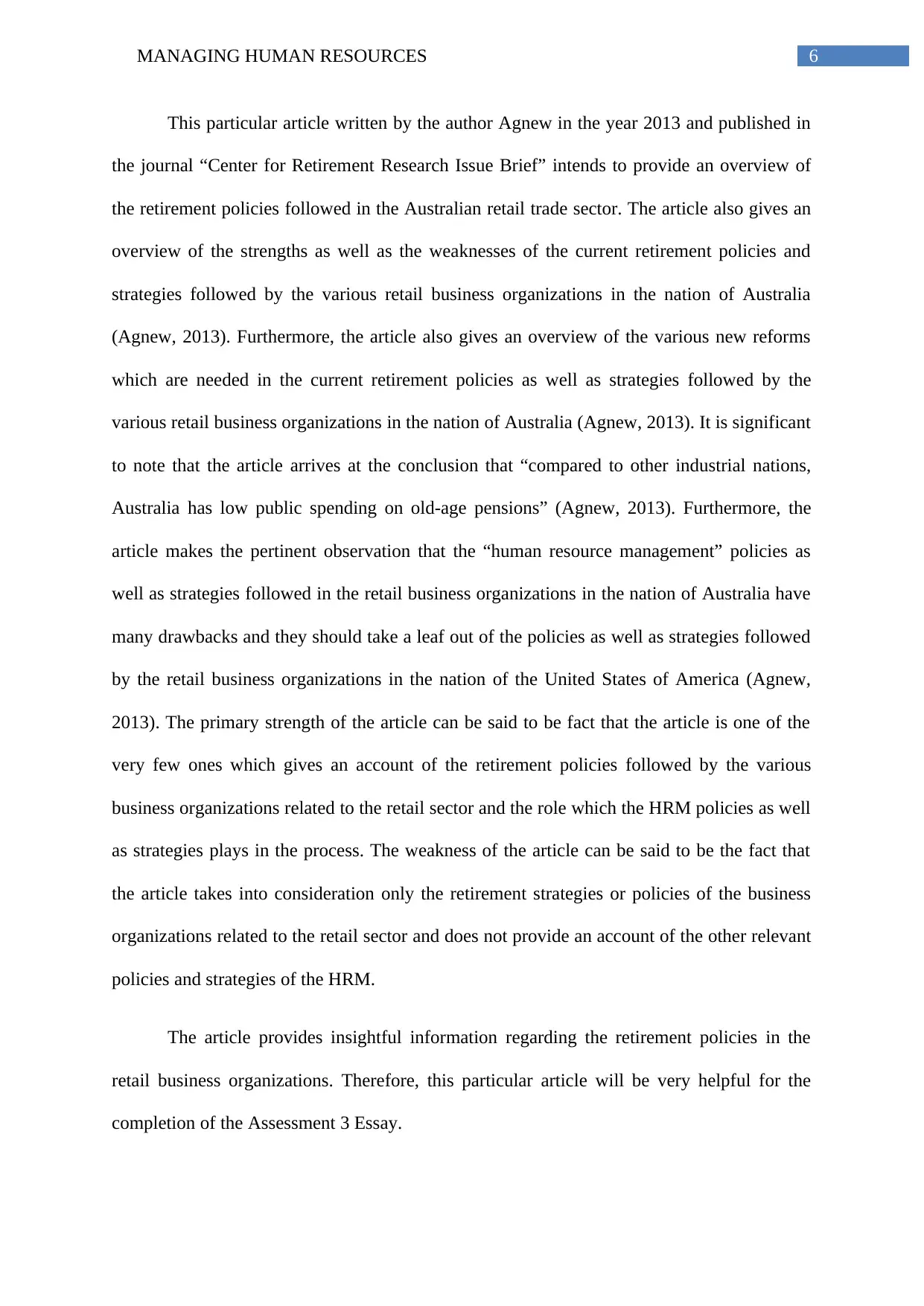
6MANAGING HUMAN RESOURCES
This particular article written by the author Agnew in the year 2013 and published in
the journal “Center for Retirement Research Issue Brief” intends to provide an overview of
the retirement policies followed in the Australian retail trade sector. The article also gives an
overview of the strengths as well as the weaknesses of the current retirement policies and
strategies followed by the various retail business organizations in the nation of Australia
(Agnew, 2013). Furthermore, the article also gives an overview of the various new reforms
which are needed in the current retirement policies as well as strategies followed by the
various retail business organizations in the nation of Australia (Agnew, 2013). It is significant
to note that the article arrives at the conclusion that “compared to other industrial nations,
Australia has low public spending on old-age pensions” (Agnew, 2013). Furthermore, the
article makes the pertinent observation that the “human resource management” policies as
well as strategies followed in the retail business organizations in the nation of Australia have
many drawbacks and they should take a leaf out of the policies as well as strategies followed
by the retail business organizations in the nation of the United States of America (Agnew,
2013). The primary strength of the article can be said to be fact that the article is one of the
very few ones which gives an account of the retirement policies followed by the various
business organizations related to the retail sector and the role which the HRM policies as well
as strategies plays in the process. The weakness of the article can be said to be the fact that
the article takes into consideration only the retirement strategies or policies of the business
organizations related to the retail sector and does not provide an account of the other relevant
policies and strategies of the HRM.
The article provides insightful information regarding the retirement policies in the
retail business organizations. Therefore, this particular article will be very helpful for the
completion of the Assessment 3 Essay.
This particular article written by the author Agnew in the year 2013 and published in
the journal “Center for Retirement Research Issue Brief” intends to provide an overview of
the retirement policies followed in the Australian retail trade sector. The article also gives an
overview of the strengths as well as the weaknesses of the current retirement policies and
strategies followed by the various retail business organizations in the nation of Australia
(Agnew, 2013). Furthermore, the article also gives an overview of the various new reforms
which are needed in the current retirement policies as well as strategies followed by the
various retail business organizations in the nation of Australia (Agnew, 2013). It is significant
to note that the article arrives at the conclusion that “compared to other industrial nations,
Australia has low public spending on old-age pensions” (Agnew, 2013). Furthermore, the
article makes the pertinent observation that the “human resource management” policies as
well as strategies followed in the retail business organizations in the nation of Australia have
many drawbacks and they should take a leaf out of the policies as well as strategies followed
by the retail business organizations in the nation of the United States of America (Agnew,
2013). The primary strength of the article can be said to be fact that the article is one of the
very few ones which gives an account of the retirement policies followed by the various
business organizations related to the retail sector and the role which the HRM policies as well
as strategies plays in the process. The weakness of the article can be said to be the fact that
the article takes into consideration only the retirement strategies or policies of the business
organizations related to the retail sector and does not provide an account of the other relevant
policies and strategies of the HRM.
The article provides insightful information regarding the retirement policies in the
retail business organizations. Therefore, this particular article will be very helpful for the
completion of the Assessment 3 Essay.
Paraphrase This Document
Need a fresh take? Get an instant paraphrase of this document with our AI Paraphraser
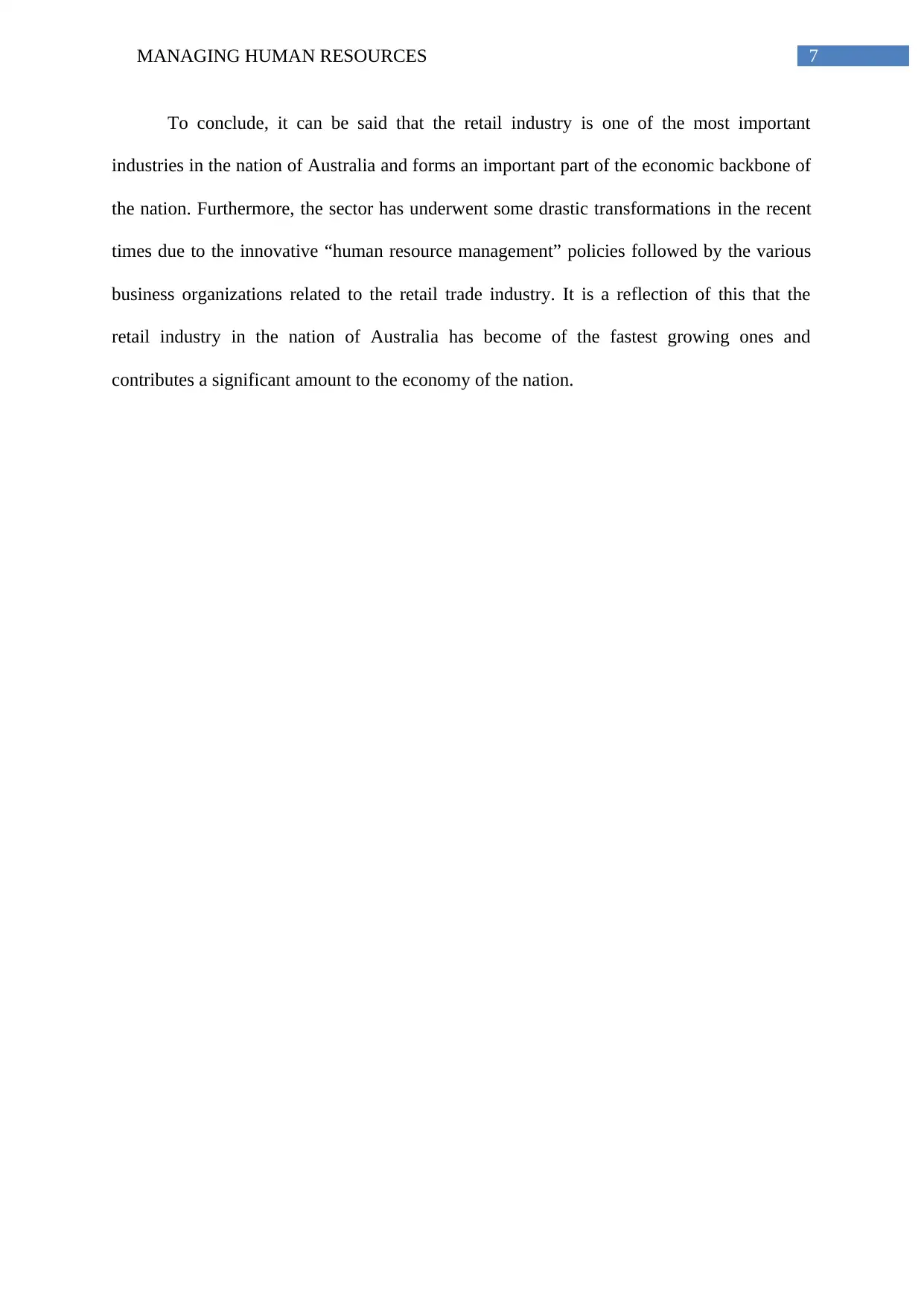
7MANAGING HUMAN RESOURCES
To conclude, it can be said that the retail industry is one of the most important
industries in the nation of Australia and forms an important part of the economic backbone of
the nation. Furthermore, the sector has underwent some drastic transformations in the recent
times due to the innovative “human resource management” policies followed by the various
business organizations related to the retail trade industry. It is a reflection of this that the
retail industry in the nation of Australia has become of the fastest growing ones and
contributes a significant amount to the economy of the nation.
To conclude, it can be said that the retail industry is one of the most important
industries in the nation of Australia and forms an important part of the economic backbone of
the nation. Furthermore, the sector has underwent some drastic transformations in the recent
times due to the innovative “human resource management” policies followed by the various
business organizations related to the retail trade industry. It is a reflection of this that the
retail industry in the nation of Australia has become of the fastest growing ones and
contributes a significant amount to the economy of the nation.
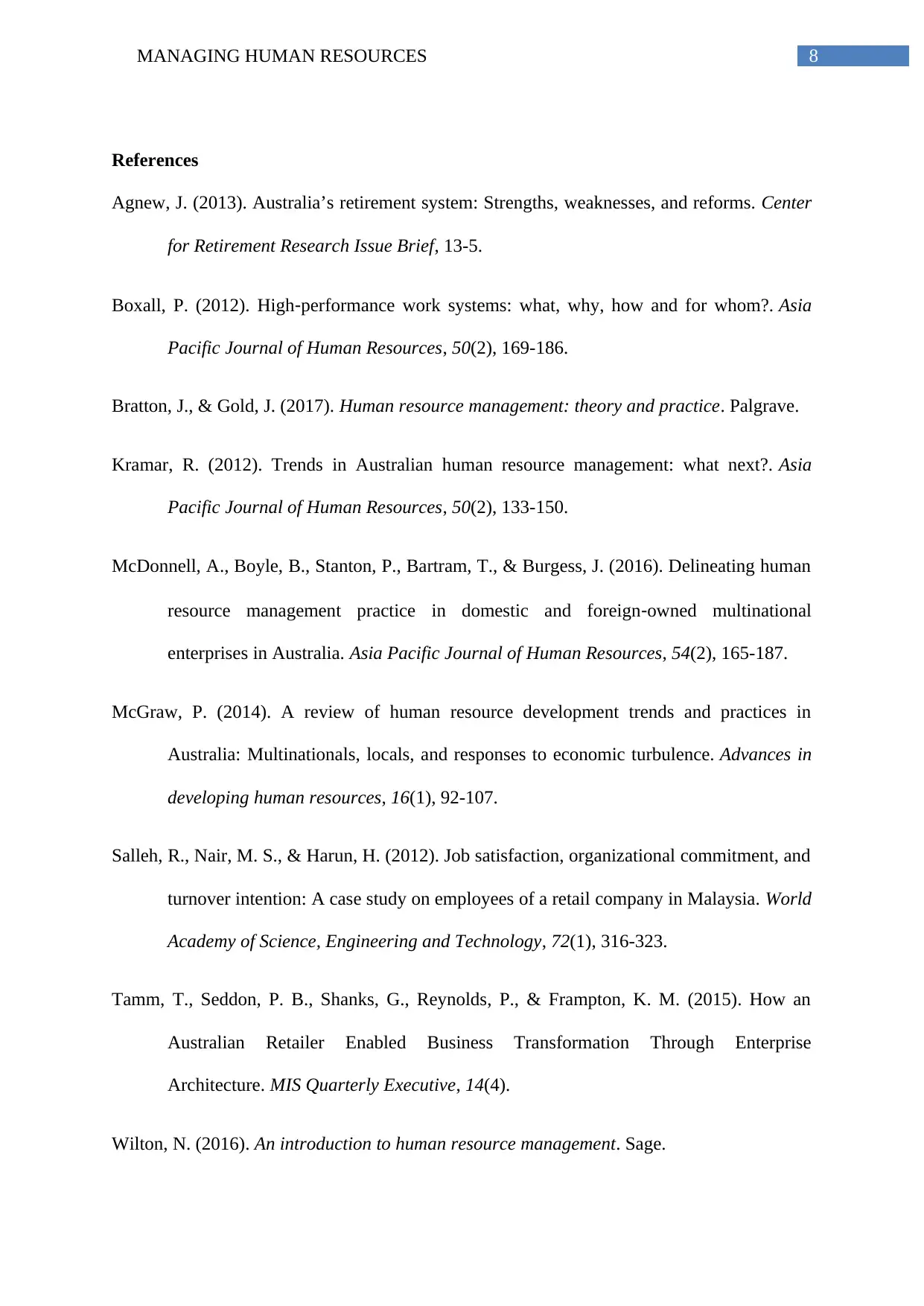
8MANAGING HUMAN RESOURCES
References
Agnew, J. (2013). Australia’s retirement system: Strengths, weaknesses, and reforms. Center
for Retirement Research Issue Brief, 13-5.
Boxall, P. (2012). High‐performance work systems: what, why, how and for whom?. Asia
Pacific Journal of Human Resources, 50(2), 169-186.
Bratton, J., & Gold, J. (2017). Human resource management: theory and practice. Palgrave.
Kramar, R. (2012). Trends in Australian human resource management: what next?. Asia
Pacific Journal of Human Resources, 50(2), 133-150.
McDonnell, A., Boyle, B., Stanton, P., Bartram, T., & Burgess, J. (2016). Delineating human
resource management practice in domestic and foreign‐owned multinational
enterprises in Australia. Asia Pacific Journal of Human Resources, 54(2), 165-187.
McGraw, P. (2014). A review of human resource development trends and practices in
Australia: Multinationals, locals, and responses to economic turbulence. Advances in
developing human resources, 16(1), 92-107.
Salleh, R., Nair, M. S., & Harun, H. (2012). Job satisfaction, organizational commitment, and
turnover intention: A case study on employees of a retail company in Malaysia. World
Academy of Science, Engineering and Technology, 72(1), 316-323.
Tamm, T., Seddon, P. B., Shanks, G., Reynolds, P., & Frampton, K. M. (2015). How an
Australian Retailer Enabled Business Transformation Through Enterprise
Architecture. MIS Quarterly Executive, 14(4).
Wilton, N. (2016). An introduction to human resource management. Sage.
References
Agnew, J. (2013). Australia’s retirement system: Strengths, weaknesses, and reforms. Center
for Retirement Research Issue Brief, 13-5.
Boxall, P. (2012). High‐performance work systems: what, why, how and for whom?. Asia
Pacific Journal of Human Resources, 50(2), 169-186.
Bratton, J., & Gold, J. (2017). Human resource management: theory and practice. Palgrave.
Kramar, R. (2012). Trends in Australian human resource management: what next?. Asia
Pacific Journal of Human Resources, 50(2), 133-150.
McDonnell, A., Boyle, B., Stanton, P., Bartram, T., & Burgess, J. (2016). Delineating human
resource management practice in domestic and foreign‐owned multinational
enterprises in Australia. Asia Pacific Journal of Human Resources, 54(2), 165-187.
McGraw, P. (2014). A review of human resource development trends and practices in
Australia: Multinationals, locals, and responses to economic turbulence. Advances in
developing human resources, 16(1), 92-107.
Salleh, R., Nair, M. S., & Harun, H. (2012). Job satisfaction, organizational commitment, and
turnover intention: A case study on employees of a retail company in Malaysia. World
Academy of Science, Engineering and Technology, 72(1), 316-323.
Tamm, T., Seddon, P. B., Shanks, G., Reynolds, P., & Frampton, K. M. (2015). How an
Australian Retailer Enabled Business Transformation Through Enterprise
Architecture. MIS Quarterly Executive, 14(4).
Wilton, N. (2016). An introduction to human resource management. Sage.
⊘ This is a preview!⊘
Do you want full access?
Subscribe today to unlock all pages.

Trusted by 1+ million students worldwide
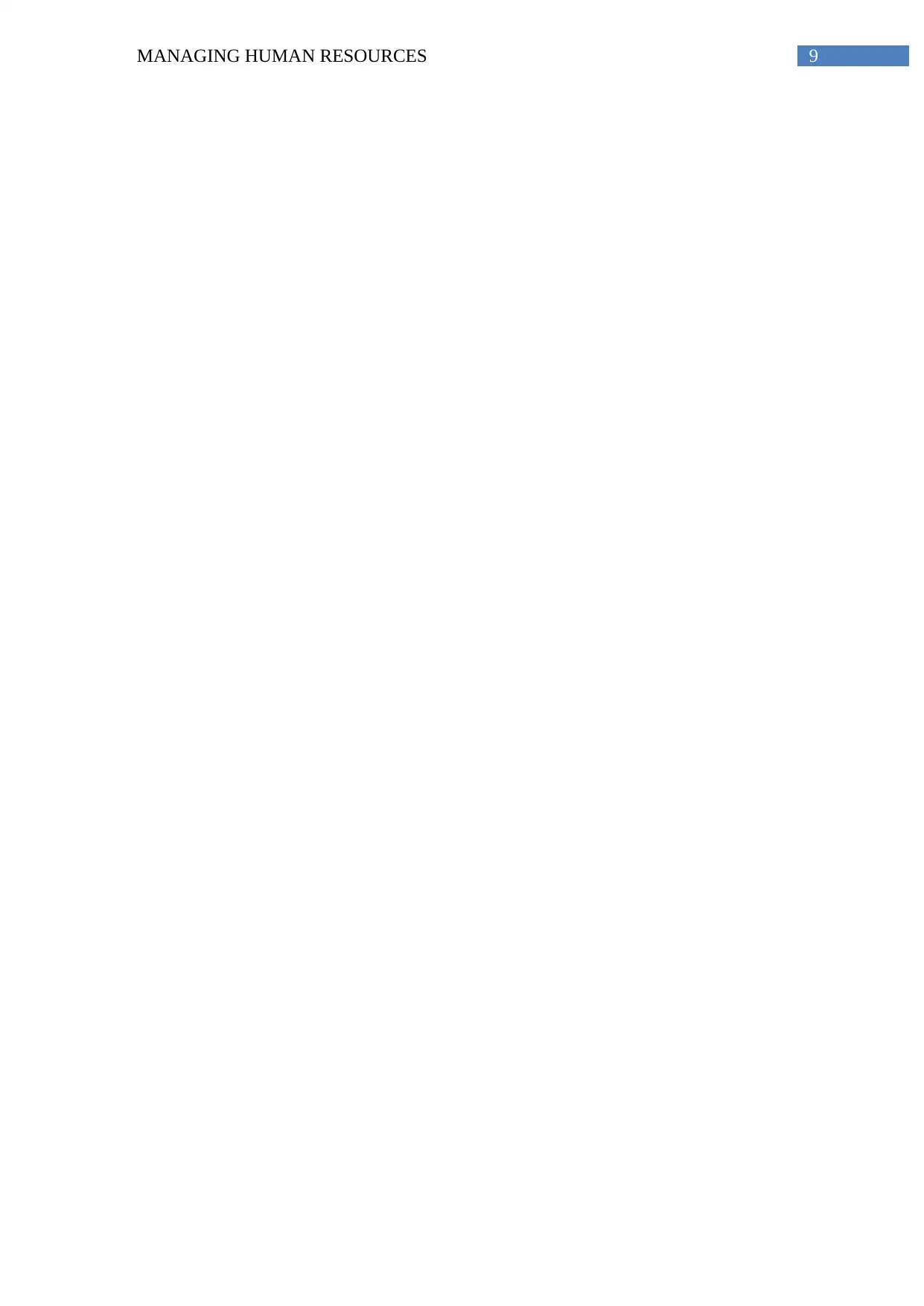
9MANAGING HUMAN RESOURCES
1 out of 10
Related Documents
Your All-in-One AI-Powered Toolkit for Academic Success.
+13062052269
info@desklib.com
Available 24*7 on WhatsApp / Email
![[object Object]](/_next/static/media/star-bottom.7253800d.svg)
Unlock your academic potential
Copyright © 2020–2025 A2Z Services. All Rights Reserved. Developed and managed by ZUCOL.



